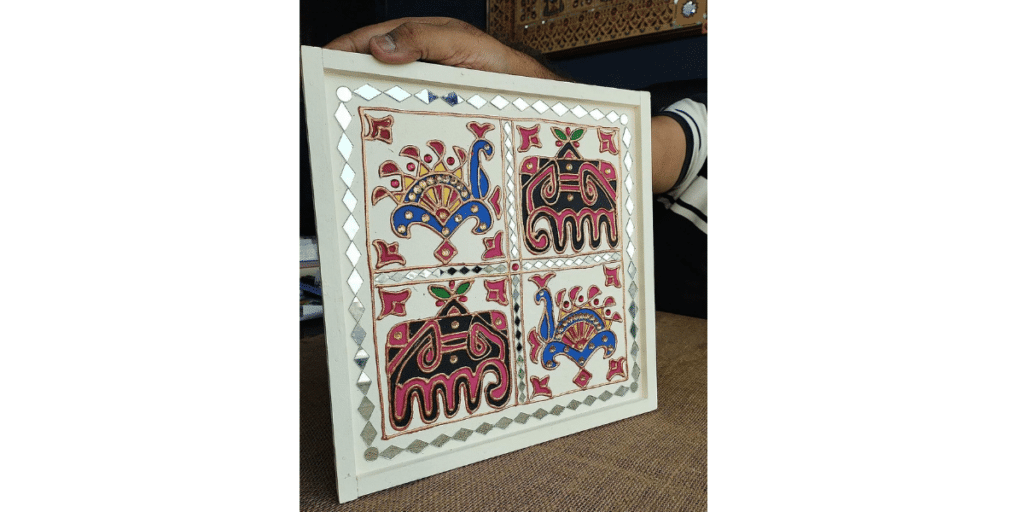In a world increasingly concerned with sustainability, eco-conscious art forms have gained prominence. Among these, Lippan art, also known as mud mirror work, stands out as a shining example of how traditional craftsmanship can intersect with the principles of sustainable living. This age-old folk art, originating in the Kutch region of India, not only creates exquisite visual wonders but also showcases a deep-rooted connection to nature and a commitment to preserving the environment.
A Symphony of Natural Materials
Lippan art is a living testament to the use of locally sourced, natural materials. The primary material is clay, typically gathered from the region where the artists reside. Clay is an eco-friendly material, abundant in nature, and does not contribute to environmental degradation. The use of clay forms the very foundation of Lippan art’s sustainability.
Water Conservation
The making of Lippan art requires minimal water usage. Given the arid landscape of Kutch, water is a precious resource. Traditional Lippan artisans are skilled in managing water efficiently, ensuring that their art doesn’t strain local water resources. This responsible approach to resource management aligns perfectly with the principles of sustainable living.

Recycled Mirrors
While Lippan art incorporates mirrors for their reflective beauty, artists often use recycled or repurposed mirrors. This practice not only reduces the demand for new materials but also minimizes the waste generated by discarded mirrors. The result is an art form that not only adds sparkle to interiors but does so without increasing the burden on landfills.
Minimal Environmental Impact
The creation of Lippan art involves minimal water and energy consumption. Artists rely on their hands and simple tools, thereby minimizing the carbon footprint of their craft. Unlike industrial processes that are resource-intensive, Lippan art is a prime example of the concept of “less is more.” This minimalism aligns with the principles of sustainability and environmental consciousness.
- Editor’s Choice
- Best Seller
- Amazon Choice
Natural Dyes and Pigments
Intricate patterns and motifs in Lippan art are often painted with natural dyes and pigments sourced from local plants, vegetables, and minerals. These dyes are both biodegradable and non-toxic, ensuring that they do not harm the environment or contaminate water sources. This eco-conscious approach to colouring ensures that Lippan art remains harmonious with its environment.
Long-Lasting Beauty
One of the most compelling aspects of Lippan art’s sustainability is its durability. When properly maintained, Lippan art can last for generations. The resilience of the materials and craftsmanship means that it doesn’t need frequent replacement or repair. This aspect contrasts with the disposability often associated with modern decor.
- Editor’s Choice
- Best Seller
- Amazon Choice
A Celebration of Nature
Lippan art is deeply rooted in nature, with many of its motifs representing the sun, moon, stars, and elements like water and fire. By celebrating the natural world through their art, Lippan artists remind us of the beauty and importance of preserving the environment. This connection to nature and the depiction of its elements in art can raise awareness about sustainability and environmental issues.
Empowering Local Communities
Furthermore, Lippan art is often crafted by local artisans who depend on the sustainability of their surroundings. Their eco-conscious approach to art creation not only safeguards their traditional skills but also their livelihoods. This art form empowers local communities to continue their way of life without harming the environment.

Conclusion
Lippan art serves as a remarkable example of how traditional art can embody eco-conscious principles. Its use of natural materials, emphasis on recycling, minimal environmental impact, and celebration of nature make it a beacon of sustainable living. In a world where ecological consciousness is paramount, Lippan art not only captivates us with its beauty but also inspires us to embrace sustainable practices in all aspects of our lives. It reminds us that art can be a reflection of our connection to the Earth and a powerful tool for promoting sustainable living.













